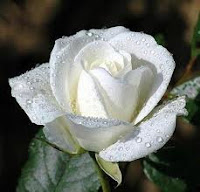A rose is a perennial plant of the genus Rosa, within the family Rosaceae. There are over 100 species. They form a group of erect shrubs, and climbing or trailing plants, with stems that are often armed with sharp prickles. Flowers are large and showy, in a number of colours from white through yellows and reds. Most species are native to Asia, with smaller numbers native to Europe, North America, and northwest Africa. Species, cultivars and hybrids are all widely grown for their beauty and fragrance. Rose plants range in size from compact, miniature roses, to climbers that can reach 7 meters in height. Species from different parts of the world easily hybridize, which has given rise to the many types of garden roses.
The name rose comes from French, itself from Latin rosa, which was perhaps borrowed from Oscan, from Greek ρόδον rhodon, related to Old Persian wrd-, Avestan varəda, Sogdian ward, Parthian wâr, Armenian vard.
Culture
Roses are a favored subject in art and therefore used in various artistic disciplines. They appear in portraits, illustrations, on stamps, as ornaments or as architectural elements. The Luxembourg born Belgian artist and botanist Pierre-Joseph Redouté is known for his detailed watercolours of flowers, particularly roses.
Henri Fantin-Latour was also a prolific painter of still life, particularly flowers including roses. The Rose 'Fantin-Latour' was named after the artist. Other impressionists including Claude Monet, Paul Cézanne and Pierre-Auguste Renoir have paintings of roses among their works.
Pests and diseases
Roses are subject to several diseases. The main fungal diseases affecting the leaves are rose black spot (Diplocarpon rosae), rose rust (Phragmidium mucronatum), rose powdery mildew (Sphaerotheca pannosa) and rose downy mildew (Peronospora sparsa). Stems can be affected by several canker diseases, the most commonly seen of which is stem canker (Leptosphaeria coniothyrium). Diseases of the root zone include honey fungus (Armillaria spp.), verticillium wilt, and various species of phytophthora.
Fungal leaf diseases affecting roses are best prevented by choosing to grow cultivars and species known to be less susceptible to attack, and by using a preventative fungicidal spray program (rather than by trying to cure an infection after it emerges on the plant). After disease is visible, spread can be minimized through pruning and the use of fungicides, although the actual infection cannot be reversed. Stem cankers are best treated by pruning out infection as soon as it is noticed. Root diseases are not usually possible to treat, once infection has occurred; the most practical line of defence is to ensure that growing conditions maximise plant health and thereby prevent infection. Phytophthora species are waterborne and therefore improving drainage and reducing waterlogging can help reduce infection.
The main pest affecting roses is the aphid (greenfly), which sucks the sap and weakens the plant. (Ladybugs are a predator of aphids and should be encouraged in the rose garden.) In areas where they are endemic Japanese beetles (Popillia japonica) take a heavy toll on rose flowers and foliage; rose blooms can also be destroyed by infestations of thrips (Thysanoptera spp). Roses are also used as food plants by the larvae of some Lepidoptera (butterfly and moth) species; see list of Lepidoptera that feed on roses. The spraying with insecticide of roses is often recommended but should be done with care to minimize the loss of beneficial insects.

